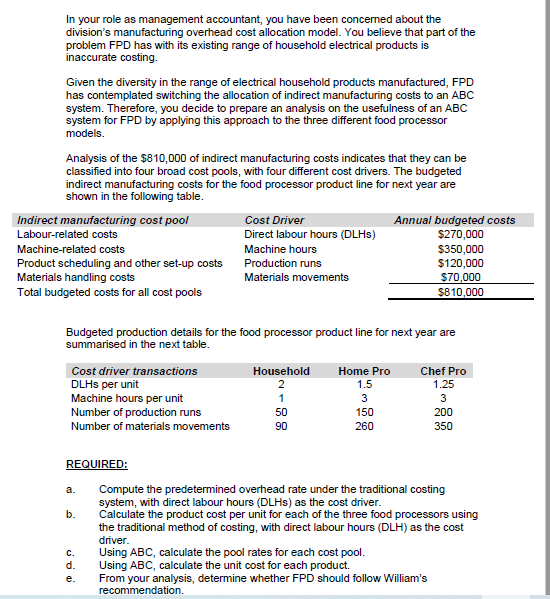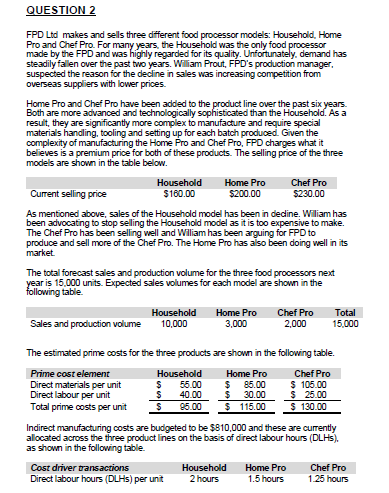In your role as management accountant, you have been concerned about the division's manufacturing overhead cost allocation model. You believe that part of the problem FPD has with its existing range of household electrical products is inaccurate costing. Given the diversity in the range of electrical household products manufactured, FPD has contemplated switching the allocation of indirect manufacturing costs to an ABC system. Therefore, you decide to prepare an analysis on the usefulness of an ABC system for FPD by applying this approach to the three different food processor models. Analysis of the $810,000 of indirect manufacturing costs indicates that they can be classified into four broad cost pools, with four different cost drivers. The budgeted indirect manufacturing costs for the food processor product line for next year are shown in the following table. Indirect manufacturing cost pool Cost Driver Annual budgeted costs $270,000 Labour-related costs Direct labour hours (DLHS) Machine-related costs Machine hours $350,000 $120,000 $70,000 $810,000 Product scheduling and other set-up costs Materials handling costs Production runs Materials movements Total budgeted costs for all cost pools Budgeted production details for the food processor product line for next year are summarised in the next table. Cost driver transactions Household Home Pro Chef Pro DLHS per unit Machine hours per unit Number of production runs 2 1.5 1.25 1 3 3 50 150 200 Number of materials movements 90 260 350 REQUIRED: Compute the predetermined overhead rate under the traditional costing system, with direct labour hours (DLHS) as the cost driver. Calculate the product cost per unit for each of the three food processors using the traditional method of costing, with direct labour hours (DLH) as the cost driver. a. b. C. Using ABC, calculate the pool rates for each cost pool.
In your role as management accountant, you have been concerned about the division's manufacturing overhead cost allocation model. You believe that part of the problem FPD has with its existing range of household electrical products is inaccurate costing. Given the diversity in the range of electrical household products manufactured, FPD has contemplated switching the allocation of indirect manufacturing costs to an ABC system. Therefore, you decide to prepare an analysis on the usefulness of an ABC system for FPD by applying this approach to the three different food processor models. Analysis of the $810,000 of indirect manufacturing costs indicates that they can be classified into four broad cost pools, with four different cost drivers. The budgeted indirect manufacturing costs for the food processor product line for next year are shown in the following table. Indirect manufacturing cost pool Cost Driver Annual budgeted costs $270,000 Labour-related costs Direct labour hours (DLHS) Machine-related costs Machine hours $350,000 $120,000 $70,000 $810,000 Product scheduling and other set-up costs Materials handling costs Production runs Materials movements Total budgeted costs for all cost pools Budgeted production details for the food processor product line for next year are summarised in the next table. Cost driver transactions Household Home Pro Chef Pro DLHS per unit Machine hours per unit Number of production runs 2 1.5 1.25 1 3 3 50 150 200 Number of materials movements 90 260 350 REQUIRED: Compute the predetermined overhead rate under the traditional costing system, with direct labour hours (DLHS) as the cost driver. Calculate the product cost per unit for each of the three food processors using the traditional method of costing, with direct labour hours (DLH) as the cost driver. a. b. C. Using ABC, calculate the pool rates for each cost pool.
Managerial Accounting
15th Edition
ISBN:9781337912020
Author:Carl Warren, Ph.d. Cma William B. Tayler
Publisher:Carl Warren, Ph.d. Cma William B. Tayler
Chapter11: Differential Analysis And Product Pricing
Section: Chapter Questions
Problem 21E
Related questions
Question

Transcribed Image Text:In your role as management accountant, you have been concerned about the
division's manufacturing overhead cost allocation model. You believe that part of the
problem FPD has with its existing range of household electrical products is
inaccurate costing.
Given the diversity in the range of electrical household products manufactured, FPD
has contemplated switching the allocation of indirect manufacturing costs to an ABC
system. Therefore, you decide to prepare an analysis on the usefulness of an ABC
system for FPD by applying this approach to the three different food processor
models.
Analysis of the $810,000 of indirect manufacturing costs indicates that they can be
classified into four broad cost pools, with four different cost drivers. The budgeted
indirect manufacturing costs for the food processor product line for next year are
shown in the following table.
Indirect manufacturing cost pool
Cost Driver
Annual budgeted costs
$270,000
$350,000
$120,000
S70,000
$810,000
Labour-related costs
Direct labour hours (DLHS)
Machine-related costs
Machine hours
Product scheduling and other set-up costs
Materials handling costs
Production runs
Materials movements
Total budgeted costs for all cost pools
Budgeted production details for the food processor product line for next year are
summarised in the next table.
Chef Pro
1.25
Cost driver transactions
Household
Home Pro
DLHS per unit
Machine hours per unit
Number of production runs
2
1.5
1
3
50
150
200
Number of materials movements
90
260
350
REQUIRED:
Compute the predetermined overhead rate under the traditional costing
system, with direct labour hours (DLHS) as the cost driver.
Calculate the product cost per unit for each of the three food processors using
the traditional method of costing, with direct labour hours (DLH) as the cost
driver.
a.
b.
Using ABC, calculate the pool rates for each cost pool.
Using ABC, calculate the unit cost for each product.
From your analysis, determine whether FPD should follow William's
C.
d.
e.
recommendation.

Transcribed Image Text:QUESTION 2
FPD Ltd makes and sells three different food processor models: Household, Home
Pro and Chef Pro. For many years, the Household was the only food processor
made by the FPD and was highly regarded for its quality. Unfortunately, demand has
steadily fallen over the past two years. William Prout, FPD's production manager,
suspected the reason for the decline in sales was increasing competition from
overseas suppliers with lower prices.
Home Pro and Chef Pro have been added to the product line over the past six years.
Both are more advanced and technologically sophisticated than the Household. As a
result, they are significantly more complex to manufacture and require special
materials handling, tooling and setting up for each batch produced. Given the
complexity of manufacturing the Home Pro and Chef Pro, FPD charges what it
believes is a premium price for both of these products. The selling price of the three
models are shown in the table below.
Home Pro
$200.00
Household
Chef Pro
Current selling price
$160.00
$230.00
As mentioned above, sales of the Household model has been in dedine. Wiliam has
been advocating to stop selling the Household model as it is too expensive to make.
The Chef Pro has been selling well and William has been arguing for FPD to
produce and sell more of the Chef Pro. The Home Pro has also been doing well in its
market.
The total forecast sales and production volume for the three food processors next
year is 15,000 units. Expected sales volumes for each model are shown in the
following table.
Household
10,000
Home Pro
3,000
Chef Pro
Total
Sales and production volume
2,000
15,000
The estimated prime costs for the three products are shown in the following table.
Prime cost element
Direct materials per unit
Direct labour per unit
Total prime costs per unit
Household
Home Pro
Chef Pro
55.00
$ 40.00
$ 85.00
$ 30.00
$ 115.00
$ 105.00
$ 25.00
$ 130.00
95.00
Indirect manufacturing costs are budgeted to be $810,000 and these are currently
allocated across the three product lines on the basis of direct labour hours (DLHS).
as shown in the following table.
Cost driver transactions
Household
Home Pro
Chef Pro
Direct labour hours (DLHS) per unit
2 hours
1.5 hours
1.25 hours
Expert Solution
This question has been solved!
Explore an expertly crafted, step-by-step solution for a thorough understanding of key concepts.
Step by step
Solved in 3 steps with 6 images

Recommended textbooks for you

Managerial Accounting
Accounting
ISBN:
9781337912020
Author:
Carl Warren, Ph.d. Cma William B. Tayler
Publisher:
South-Western College Pub

Cornerstones of Cost Management (Cornerstones Ser…
Accounting
ISBN:
9781305970663
Author:
Don R. Hansen, Maryanne M. Mowen
Publisher:
Cengage Learning

Financial And Managerial Accounting
Accounting
ISBN:
9781337902663
Author:
WARREN, Carl S.
Publisher:
Cengage Learning,

Managerial Accounting
Accounting
ISBN:
9781337912020
Author:
Carl Warren, Ph.d. Cma William B. Tayler
Publisher:
South-Western College Pub

Cornerstones of Cost Management (Cornerstones Ser…
Accounting
ISBN:
9781305970663
Author:
Don R. Hansen, Maryanne M. Mowen
Publisher:
Cengage Learning

Financial And Managerial Accounting
Accounting
ISBN:
9781337902663
Author:
WARREN, Carl S.
Publisher:
Cengage Learning,

Accounting Information Systems
Accounting
ISBN:
9781337619202
Author:
Hall, James A.
Publisher:
Cengage Learning,